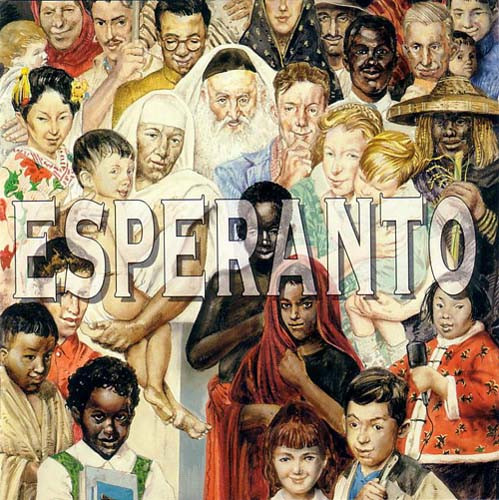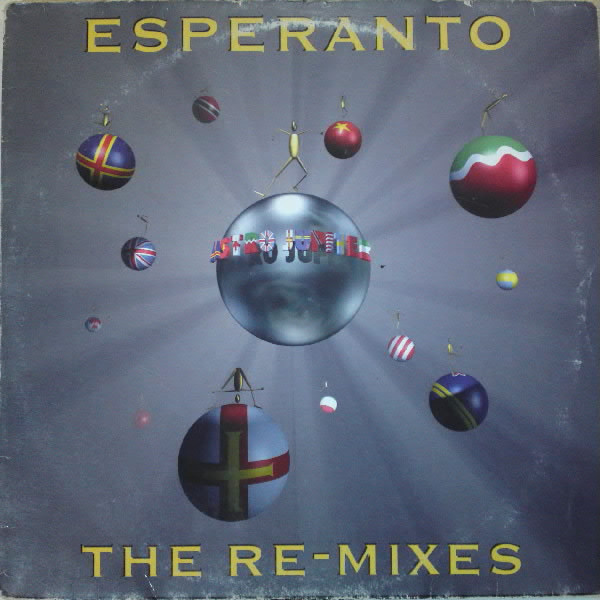Julián Ruiz
While Esperanto music has an active independent scene, the language has very rarely been used in popular music released on major labels. Only two such albums come to mind: the 1999 Freundeskreis album Esperanto (which has some Esperanto lyrics, mostly in the very first track, but is otherwise in German, English and French), and a 1996 release by Warner Music Spain, also entitled simply Esperanto.

Very little information about the people involved in the creation of the album is given on the cover or in the liner notes. The credits simply say: “Produced by Esperanto. This album was recorded in Sofia, Johanesburgh (sic), La Habana, Moscow, Madrid, Edimburgh (sic) and Rio de Janeiro”, although the album’s entry on Discogs helpfully links to a producer: Julián Ruiz.
Ruiz was born in Murcia in southern Spain in 1950 and, according to the Spanish Wikipedia, “is considered one of the most important producers in the history of Spanish pop music”. Discogs lists nearly 200 production credits between 1975 and 2024, in a wide variety of styles and genres - but as usual for this blog, we will concentrate on his Esperanto work.
The album consists of 11 tracks of electronic music with choral vocals. All of the melodies are taken from well-known classical pieces, mostly instrumentals, with newly-written Esperanto lyrics. These lyrics are in well-written and well-sung Esperanto, but are all very short, and as such generally present simple snapshots of ideas rather than anything more substantial or complex. The lyrics are all listed in the accompanying booklet, along with translations (literal rather than singable) into English, French, German, Italian, Spanish and Japanese.
In many cases, the titles and lyrics refer in some way to the original pieces, but some have no obvious connection. Three of the songs refer directly to Esperanto: the title track, the track Zamenhof, and the track La Rido, which contains the lyric “Ĉiu popolo lernu sian propran linvgon kaj Esperanton, la lingvo de l’ homaro” (translated in the booklet as “Each people must learn its own language and Esperanto, the mankind’s language”).
Reflecting on the album in 2024 as one of his favourite productions, Ruiz described how his father was an Esperanto enthusiast and how he had always wanted to make a record in that language. His favourite song from the album is the title track, the only original composition included, and the vocal performance was described by Ruiz as “unbelievably wonderful”.
| Song | Based on |
|---|---|
| Astro Jupiter’ | Jupiter from “The Planets” (Holst) |
| Mistero Numero Kvin | Symphony No 5, 2nd Movement (Tchaikovsky) |
| Maro Sadko | Hindu Song from “Sadko” (Rimsky-Korsakov) |
| Tirano | Rhapsody on a Theme of Paganini, Variation 18 (Rachmaninoff) |
| Thais | Meditation from “Thaïs” (Massenet) |
| Zamenhof | Symphony No 3, 3rd Movement (Brahms) |
| Lumo | Symphony No 9 (“From the New World”), 4th Movement |
| Universala Naturo | Pomp and Circumstance March No 1 (Elgar) |
| Cigno | The Swan from “Carnival of the Animals” (Saint-Saëns) |
| La Rido | Symphony No 9, 4th Movement (“Ode to Joy”) (Beethoven) |
| Esperanto | original composition |

Golden Rule by Norman Rockwell
The album’s cover is an edited reproduction of “Golden Rule” by the American artist Norman Rockwell, painted in 1961. Rockwell’s painting was intended to represent as many different ethnicities and cultures as possible, and his research for the piece involved a journey around the world in 1955, taking photos of people from many different cultures engaging in their own traditions and practices. The painting originally appeared on the cover of the Saturday Evening Post magazine in April 1961, and was later adapted as a mosaic at the headquarters of the United Nations in New York.

Alongside the album, an EP of remixes of the first track, Astro Jupiter’, was also produced. This EP was issued in two versions: a CD featuring the radio edit, album version, and four remixes; and a 12" vinyl record containing the four remixes. To my knowledge, this is the only 12" 45rpm EP of Esperanto music ever released. As Esperanto music is usually produced on a low budget and has to be shipped internationally, the added costs of a 12" EP would generally make that format impractical - and so Esperanto vinyl releases longer than a standard 7" single but shorter than a full album tended to be produced as a 7" 33⅓rpm record instead. It’s therefore no surprise that the only 12" 45rpm record is also the only major label release.
The 1997 edition of the Esperanto music magazine Rok-Gazet’ dedicated most of a double-page spread to the album and EP, noting that the album was released in Spain and promoted with a TV ad campaign and significant radio airplay, and had received a number of reviews in the Spanish music press. Unfortunately I wasn’t able to find any of these, but if any reader has access to Spanish newspaper archives and can find anything relevant, please do let me know in the comments!
Rok-Gazet’ contained two contrasting reviews of the album, and mentioned a further one published in the Catalan Esperanto youth magazine Kata Luno, which I haven’t been able to track down. Both Rok-Gazet’ reviewers agreed that the singing was quite hard to understand, but disagreed on their overall opinion of the album: one reviewer felt that the album was well produced but rather boring to listen to, but the other described it as “very good” and stated that he had already bought four copies to give away to friends!
Discography and Sources
- Discogs
- Spanish Wikipedia - Julián Ruiz
- Plásticos y Decibélios - La 20 Mejores Producciones de Julian Ruiz
- Rok-Gazet’ issue 08, pages 12-13
- Golden Rule by Norman Rockwell
Comments
Comments are welcome in any language, especially Esperanto.
All comments are moderated before publication.
Komentoj estas bonvenoj en ĉiuj lingvoj, aparte en Esperanto.
Ĉiuj komentoj estos kontrolitaj antaŭ publikigo.